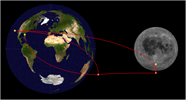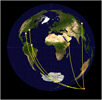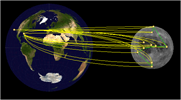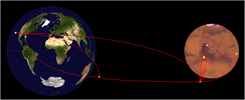SpaceNet 2.5
The most recent development of SpaceNet 2.5 was supported by the NASA Jet Propulsion Laboratory (JPL) under the Strategic University Relations Program (SURP) and contract number 1344341.
The primary goals of SURP research effort were to better model the life-cycle "-ilities" of space exploration (Reusability, Reconfigurability, Repairability, and Commonality). A secondary goal was established to improve the usability and scenario flexibility of the software.
In October 2009, SpaceNet 2.5 was released to the public under an open source license in hopes of stimulating a user community in the area of space exploration logistics.
Analysis Capabilities
Reusability
As human habitation duration is stretched to longer periods at remote outposts, utilizing pre-positioning of resources and infrastructure becomes essential. Reusability focuses on the reuse of elements across missions, including pre-positioning and re-positioning planetary assets for future use. The challenges of implementing reusability included decoupling elements from specific missions and persisting elements and their effects on demands throughout the entire simulation.
Reconfigurability
Faced with the enormous expense of delivering infrastructure to remote locations, infrastructure elements will have to perform more than one function to save on mass and upkeep. Reconfigurability focuses on defining operational states for elements which can be dynamically changed according to mission plan. The operational state defines the element's duty cycle and models used to generate demands for resources. The challenges of implementing reconfigurability included sufficiently describing different operational states of elements and dynamically changing the underlying models generating demands.
Commonality
With infrequent resupply missions, future exploration must make the most of existing spares stocks. Commonality focuses on creating common parts for elements so methods like spares pooling and scavenging from unused elements can be used to decrease demands for spare parts throughout the scenario. The challenges of implementing commonality included adding the ability to scavenge from existing elements and developing a metric to evaluate scenario commonality.
Repairability
As human surface duration is extended and crew time becomes more available, repair rather than replacement may become a desirable action for broken or damaged parts. Repairability focuses on creating repairable parts for elements where crew time can be traded for reduced spares demands via corrective repair activities. The challenges of implementing repairability included adding the ability to choose repair actions and evaluating the impact on the overall scenario.
Use Case Scenarios

|
Lunar SortieThe Lunar Sortie use case models a single Constellation-class mission for a seven-day duration exploration of the Lunar South Pole, serving as a validation scenario to match existing capability. |

|
International Space Station (ISS) ResupplyThe ISS Resupply use case models the sustainment of the International Space Station post shuttle retirement (2010-2015) utilizing a combination of International Partners (IP) and Commercial Orbital Transportation Services (COTS). Challenges associated with this use case include a non-zero initial state and requirements for detailed models to accurately model demands for resources and spare parts. |

|
Lunar Hub-Spoke (Outpost) CampaignThe Lunar Hub-Spoke use case models the build-up and sustainment of an outpost at the Lunar South Pole. Challenges associated with this use case include a high level of element reuse across missions and an increasing dependence on ISRU technology. |

|
Lunar Spoke-Hub (Global Exploration) CampaignThe Lunar Spoke-Hub use case models a global exploration of the Moon including a multi-mission traversal from the Lunar North Pole to the Lunar South Pole using a mobile habitation element. Challenges associated with this use case include multi-destination missions and capturing surface-to-surface transportation. |

|
Mars Human-Robotic Exploration CampaignThe Mars use case models a precursor robotic exploration of the Martian surface, followed by human-crewed missions based on Mars Design Reference Architecture 5.0. Challenges associated with this use case include a high variance of launch windows and flight duration associated with orbital dynamics, increasing concern for alternative propulsion methods, and increasing health concerns for long-term human space habitation. |

